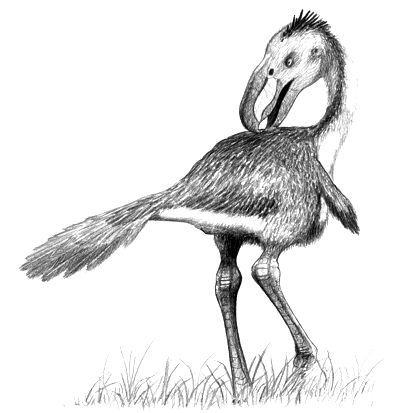|
Procariama
''Procariama'' is an extinct monotypic genus of phorusrhacid, which lived from the Late Miocene to the Late Pliocene (11-2 million years ago) of Argentina. Fossils of the animal have been found in six places, in the Cerro Azul and Andalhuala Formations. More specifically in the Andagalá department and in the north of the Belén department of the Catamarca province, with a single location in the La Pampa province. The type and only species, ''Procariama simplex'', is the largest member of the subfamily Psilopterinae. History of Discovery The lectotype of ''Procariama'' (MACN-8225) is a partial skeleton consisting of an incomplete skull, a pelvis, proximal and distal parts of the left femur, distal parts of the right tibiotarsus, proximal and distal parts of the right tarsometatarsus, foot bones and the nail bearing toe bones of the nearly complete left foot, and fragments of the toe bones of the right foot. The genus name was first published in 1914 by Cayetano Rovereto in '' ... [...More Info...] [...Related Items...] OR: [Wikipedia] [Google] [Baidu] |
Cerro Azul Formation
The Cerro Azul Formation ( es, Formación Cerro Azul), in the Buenos Aires Province also described as Epecuén Formation, is a geological formation of Late Miocene (Tortonian, or Huayquerian in the SALMA classification) age in the Colorado Basin of the Buenos Aires and La Pampa Provinces in northeastern Argentina.Cerro Azul Formation in the Epecuén Formation in the |
Phorusrhacid Skulls Comparison
Phorusrhacids, colloquially known as terror birds, are an extinct clade of large carnivorous flightless birds that were one of the largest species of apex predators in South America during the Cenozoic era; their conventionally accepted temporal range covers from 62 to 0.1 million years ( Ma) ago. They ranged in height from . Their closest modern-day relatives are believed to be the seriemas. ''Titanis walleri'', one of the larger species, is known from Texas and Florida in North America. This makes the phorusrhacids the only known large South American predator to migrate north in the Great American Interchange that followed the formation of the Isthmus of Panama land bridge (the main pulse of the interchange began about 2.6 Ma ago; ''Titanis'' at 5 Ma was an early northward migrant). It was once believed that ''T. walleri'' became extinct in North America around the time of the arrival of humans, but subsequent datings of ''Titanis'' fossils provided no evidence for their ... [...More Info...] [...Related Items...] OR: [Wikipedia] [Google] [Baidu] |
Psilopterinae
Phorusrhacids, colloquially known as terror birds, are an extinct clade of large carnivorous flightless birds that were one of the largest species of apex predators in South America during the Cenozoic era; their conventionally accepted temporal range covers from 62 to 0.1 million years ( Ma) ago. They ranged in height from . Their closest modern-day relatives are believed to be the seriemas. ''Titanis walleri'', one of the larger species, is known from Texas and Florida in North America. This makes the phorusrhacids the only known large South American predator to migrate north in the Great American Interchange that followed the formation of the Isthmus of Panama land bridge (the main pulse of the interchange began about 2.6 Ma ago; ''Titanis'' at 5 Ma was an early northward migrant). It was once believed that ''T. walleri'' became extinct in North America around the time of the arrival of humans, but subsequent datings of ''Titanis'' fossils provided no evidence for their ... [...More Info...] [...Related Items...] OR: [Wikipedia] [Google] [Baidu] |



